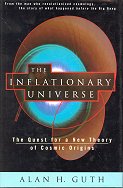This is the long-awaited story of the struggle to formulate a single viable theory of the origins of the universe, by the cosmologist who was at the forefront of that research.
Rarely have any scientist’s predictions been so dramatically confirmed as when NASA’s COBE satellite measured the pattern of the cosmic background radiation for the first time in 1992. The results emphatically demonstrated that Alan Guth’s decade-long quest to justify his Inflationary Universe Theory had not been in vain.
The classic Big Bang Theory neatly described what happened after the bang. Yet, until recently, particle physicists and cosmologists were stuck on many questions that the Big Bang Theory still couldn’t answer: If matter can neither be created nor destroyed, how could so much matter arise from nothing at all? Why is the universe as large as it is? The Infiationary Universe Theory is the only one that answers these critical questions.
From the early days of intellectual curiosity to the victory of experimental confirmation, physicist Alan Guth tells the first-hand story of his remarkable quest to discover how the universe began.
The Big Bang theory of the origin of the universe explains many observed features – including the cosmic abundance of light elements, and the 2.7K microwave background – but there are some things it does not explain – such as why is the universe (very close to being) flat, exquisitely poised between expanding forever and falling to a Big Crunch, and why is it so isotropic? These features have to be built into the model as (rather implausible) parameters, rather than naturally emerging as consequences of the theory. Alan Guth here explains inflation, the cosmological theory of what happened in the first 10-35 seconds, when the universe expanded in size by very many orders of magnitudes (and then continued to evolve as the conventional Big Bang model explains), which does explain these features.
Guth is well placed to explain the theory: he invented it, in 1980. I was starting my PhD in astrophysics around this time (in a different area) and I remember the excitement down the corridor that this new theory was generating, but I did not know nearly enough about the area to be able to understand the highly technical papers being published. Now I am glad to have a comprehensible explanation – with added historical context – of what all that excitement was about.
The first few chapters provide a good refresher in the history and concepts of standard cosmology and the Big Bang theory. But it is at chapter 10 that the real fun starts, because Guth tells the story of the development of the inflationary theory as it happened – and he brings out the sheer excitement of participating in this development, as well as giving a nice explanation of the theory itself. What is made clear is the speed of the discovery, the coincidences that led to its development, how many people were working on very similar ideas, and how the significance of some earlier discoveries hadn’t been recognised at the time.
Guth lucidly explains what inflation is, how it solves the earlier problems (of “horizon, flatness, homogeneity, isotropy, and primordial monopoles”, as the title of a paper by Linde summarises), how it predicted the observed spectrum of matter fluctuations, stunningly borne out by COBE a decade later, and how it still has (a few) problems of its own. I particularly liked the intuitive explanation of the negative pressure of the “false vacuum”. He then goes on to some more speculative, but just as interesting chapters, about continuous inflation resulting in a fractal distribution of an infinite number of Big Bang-like universes (leading to an amusing melding of lots of “pocket” Big Bangs happening within an essentially Steady State universe), about the creation of inflating universes “in the lab”, and about creating the universe “from nothing”.
This is still a burgeoning research area, but it is clear that some of the problems will not be solved until the underlying particle physics is better understood. In a couple of footnotes Guth wonders (in 1997) if the new superstring theories hold the answer. Time will tell.
I do have one gripe about the book: the physical units Guth chooses to use. For some reason, he uses CGI units – grams, centimetres, ergs, dynes – rather than SI units – kilograms, metres, joules, newtons – which gives the book a curiously old-fashioned air in places. Now, astrophysicists and cosmologists also use their own peculiar bunch of units for certain particular measurements – so masses are often expressed in multiples of the mass of the sun, and distances in parsecs, for example. So my main unit-gripe is in relation to the Hubble constant, which is always quoted in “kilometres per second per megaparsec” (so much so that in conversation one doesn’t even bother to mention the unit), but here Guth uses the idiosyncratic “kilometres per second per million light years”, requiring an irritating mental multiplication by 3.26 whenever a value is seen.
However, that gripe is minor. Here is a great account, both of the currently best-accepted model of the origin of the universe in all its weirdness, and of the sheer intellectual excitement of scientific discovery.
